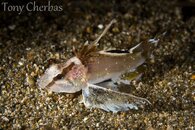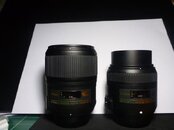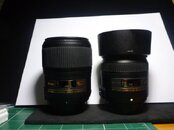You are using an out of date browser. It may not display this or other websites correctly.
You should upgrade or use an alternative browser.
You should upgrade or use an alternative browser.
Nikon 40mm lens
- Thread starter Magrone
- Start date
Please register or login
Welcome to ScubaBoard, the world's largest scuba diving community. Registration is not required to read the forums, but we encourage you to join. Joining has its benefits and enables you to participate in the discussions.
Benefits of registering include
- Ability to post and comment on topics and discussions.
- A Free photo gallery to share your dive photos with the world.
- You can make this box go away
At that distance lighting of the subject becomes difficult.
Thanks Iamwayne,
I figured this much, I would not put this lens on with the intention of shooting Nudibranchs! ...But the slower focusing is now what worries me. I tried shooting the Tokina 35mm and could not stand how slow the auto focus was compared to the 60 ( this was on a Canon t2i though) underwater. I returned it without hesitation. If the Nikon 40mm is like the Tokina 35mm then I can't say I would ever use it. This range, for medium sized reef fish, in my mind, is strictly for auto focus shots that need to be fast to catch the right moment. Thank you very much for this feedback
Thanks Iamwayne,
I figured this much, I would not put this lens on with the intention of shooting Nudibranchs! ...But the slower focusing is now what worries me. I tried shooting the Tokina 35mm and could not stand how slow the auto focus was compared to the 60 ( this was on a Canon t2i though) underwater. I returned it without hesitation. If the Nikon 40mm is like the Tokina 35mm then I can't say I would ever use it. This range, for medium sized reef fish, in my mind, is strictly for auto focus shots that need to be fast to catch the right moment. Thank you very much for this feedback
I don't think you have to worry about focusing speed that much; After all it is an AF-S, unlike the screw driven Tokina. The comparison I made earlier was with the 60mm AF-S, which is a speed champion! You can gain more focusing speed by switching on the focus limiter, provided that you are willing to settle for ~1:3 reproduction ratio (which still allows you to take some decent picture of large nudis). With that setup, I find the focusing speed perfectly acceptable.
You can have a look at the pictures I have taken with this set up. There are certain degree of cropping on most photos, I find the remaining pixels are still ok for my purpose
All picture taken with 40mm AF-S micro and D7000
https://www.facebook.com/media/set/?set=a.10150631718577071.410555.557897070&type=3&l=370acd6f16
The daytime photos (first 20 or so) were taken with the 40mm AF-S micro and D7000
https://www.facebook.com/media/set/?set=a.10150633531537071.410891.557897070&type=3&l=aa22b32a2b
Wayne
Thanks Wayne,
There are some very good examples in those sets of what I am hoping for from this lens. Thanks very much for this review. This lens is very intriguing. I am taking a trip back to Anilao in May and this lens seems like a good addition to my macro set up. I also shoot with the D7000 in a Nauticam housing. However, I have the macro port for the 60mm that has 67mm threading for my Subsee diopter. Given the smaller port window on this port, any chance that you know if this port is still compatible with the 40mm without vignetting? Thanks.
There are some very good examples in those sets of what I am hoping for from this lens. Thanks very much for this review. This lens is very intriguing. I am taking a trip back to Anilao in May and this lens seems like a good addition to my macro set up. I also shoot with the D7000 in a Nauticam housing. However, I have the macro port for the 60mm that has 67mm threading for my Subsee diopter. Given the smaller port window on this port, any chance that you know if this port is still compatible with the 40mm without vignetting? Thanks.
Also, Wayne, Do you know the name of the fish in pic DSC_8245? Very nice shot BTW. I saw this one at Anilao Pier back in November but not free swimming in the water column. Was this natural behavior or was it provoked to swim? And was the auto-focus adequate enough for this type of shot? I find that with the 60mm (Canon version, I have not tried the Nikon version yet) it is a challenge to shoot squid in the water column at night because of focusing issues, even with a good focus light.

Those are very nice, Wayne. The macro is surprisingly good. Did you crop much or are those full size?
Perhaps a 1.4 teleconverter might even gain some working distance. Did you take anything wider? My take on the 40 vs. 60 is that it might allow larger subjects at a relatively close distance. I've used my 35 to take shots of things like Mola's, Angel Sharks, Sea Lions and small schools of fish at a distance of about 3-5 feet. With my 10-17 they look tiny and can be harder to light, with the 35 they fill the shot better, but it isn't nearly as sharp as it could be and it's slow focusing.
Perhaps a 1.4 teleconverter might even gain some working distance. Did you take anything wider? My take on the 40 vs. 60 is that it might allow larger subjects at a relatively close distance. I've used my 35 to take shots of things like Mola's, Angel Sharks, Sea Lions and small schools of fish at a distance of about 3-5 feet. With my 10-17 they look tiny and can be harder to light, with the 35 they fill the shot better, but it isn't nearly as sharp as it could be and it's slow focusing.
Thanks Wayne,
There are some very good examples in those sets of what I am hoping for from this lens. Thanks very much for this review. This lens is very intriguing. I am taking a trip back to Anilao in May and this lens seems like a good addition to my macro set up. I also shoot with the D7000 in a Nauticam housing. However, I have the macro port for the 60mm that has 67mm threading for my Subsee diopter. Given the smaller port window on this port, any chance that you know if this port is still compatible with the 40mm without vignetting? Thanks.
On the port:
I have no experience in the Nauticam system so I can only offer advice based on my own setup. My Aquatica flat port was designed for 60mm on full frame camera. Because:
1) a 40mm on DX camera covers the same field of view as the 60mm+FF; and
2) the 2 lens are approximately the same length.
I had no problem with vignetting at all.
Along the same logic, if your port is fitted for 60mm+FF it's highly likely that it can be used without vignetting problem.
On focusing issue:
The shot (waspfish) was taken with the 60mm, but I think it would be easier with the 40mm's larger field of view because one could pick-up and track the subject better in the viewfinder. I usually put my wide beam focus light at a rather high center position and adjust the tilt so the cone of light only illuminates the approximate area I want to focus. If anything enters the light cone, both the camera and you will see the brightly lit subject. I find this particularly useful for locating subject in mid water column at night.
On the fish:
The fish is called ocellated waspfish. It’s normally a bottom dweller, half burying itself in sand… until it got fed up with us
Wayne
Last edited:
Larry,
On cropping:
Some are full size but many have been cropped. The vertical ones in the albums were all taken horizontally with cropping in mind. I crop later simply because I am too lazy to adjust the flash position when shooting dual flash. There are over 7 megapixels left after such crop, which is more than enough for 12”x18” if printing is required. I have cut some photos down to 4 megapixels and they are still fine for 8”x12”. I am not a very critical person .
.
On tele extender:
I think the 60mm micro is a better solution than the 40mm+1.4x tele extender.
I love the Tokina 10-17mm. Combining it with the 1.4x and a 4 inch port is something I would really want to try!
On cropping:
Some are full size but many have been cropped. The vertical ones in the albums were all taken horizontally with cropping in mind. I crop later simply because I am too lazy to adjust the flash position when shooting dual flash. There are over 7 megapixels left after such crop, which is more than enough for 12”x18” if printing is required. I have cut some photos down to 4 megapixels and they are still fine for 8”x12”. I am not a very critical person
On tele extender:
I think the 60mm micro is a better solution than the 40mm+1.4x tele extender.
I love the Tokina 10-17mm. Combining it with the 1.4x and a 4 inch port is something I would really want to try!
Last edited:
After looking through the first set again, the rays and the lionfish are close to what I had in mind. Big enough that you'd have to back up too much with the 60 and lose some color and sharpness to the water column.
The shot with the reef in the background illustrates the exact same issue I have with the 60. The macros don't do wider shots well because the background blurs, but not enough to be artistic. On land, you get bokeh. Underwater, you get fuzzy looking coral. It definitely seems to need a blue water background.
The shot with the reef in the background illustrates the exact same issue I have with the 60. The macros don't do wider shots well because the background blurs, but not enough to be artistic. On land, you get bokeh. Underwater, you get fuzzy looking coral. It definitely seems to need a blue water background.
Similar threads
- Replies
- 0
- Views
- 187
- Replies
- 2
- Views
- 367






